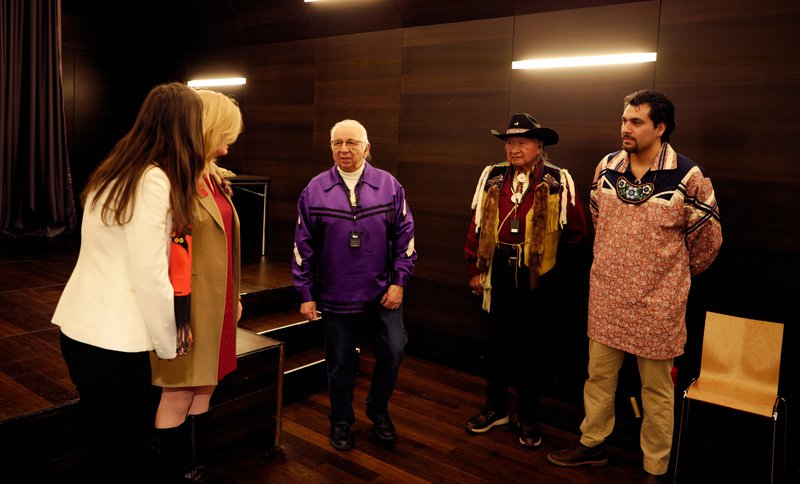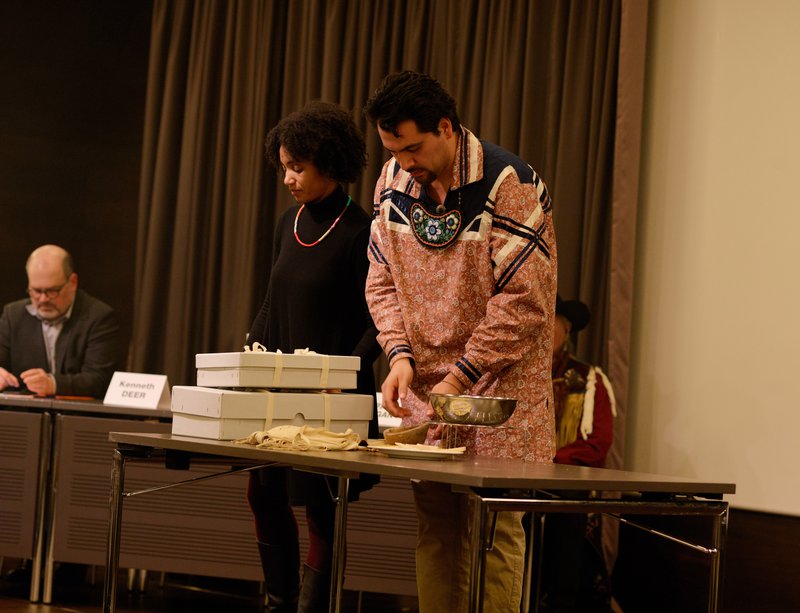Sacred Indigenous Objects Find Their Way Home
In “an international act of diplomacy,” Syracuse University alumnus Brennen Ferguson ’19 helps repatriate ceremonial Native American items from a museum in Geneva, Switzerland.

Syracuse University alumnus Brennen Ferguson (right) and fellow Haudenosaunee External Relations Committee members Kenneth Deer (middle) and Clayton Logan (second from right) assisted in the repatriation of sacred cultural items from the Geneva Museum of Ethnography.
Travel to just about any major ethnographic and natural history museum around the world and you will encounter installations focusing on Native American and Indigenous society and culture. Exhibits such as the American Museum of Natural History’s Hall of Plains Indians in New York City feature objects like games, weapons, agricultural tools and clothing which help tell the story of the Indigenous peoples of the Americas.
While most museums display Native American artifacts accurately and respectfully, there are instances where objects are either misrepresented or exhibited without permission. According to Scott Manning Stevens, associate professor of English and director of both the Native American and Indigenous studies program and the Center for Global Indigenous Cultures and Environmental Justice, this often happens when items are collected, displayed and interpreted by non-Indigenous institutions and without consultation from affiliated tribal representatives. To help address this issue among the next generation of museum curators and directors, Stevens, who is a Mohawk citizen of the Haudenosaunee Confederacy, has developed courses in the College of Arts and Sciences which teach students about equitable and inclusive museum practices.
Repatriating Sacred Items
One of the students Stevens mentored at Syracuse University was Brennen Ferguson ’19, a Tuscarora citizen who majored in communication and rhetorical studies in the College of Visual and Performing Arts. As an undergraduate at Syracuse, Ferguson enrolled in several of Stevens’ classes, which he says taught him a great deal about Haudenosaunee diplomacy. He now applies those valuable lessons to his work as a member of the external relations committee of the Grand Council of the Haudenosaunee Confederacy, in which Ferguson and other members maintain and build upon relationships with friendly states around the world.
Ferguson’s role on that committee brought him to Geneva, Switzerland, in July 2022 with other delegates to attend the annual United Nations summit of the Expert Mechanism on the Rights of Indigenous Peoples (EMRIP). EMRIP, which was established in 2007 by the United Nation’s main human rights body, holds a five-day session each year in which representatives from states, Indigenous communities, civil society, academia and inter-governmental organizations discuss ways to promote and protect Indigenous Peoples’ rights.
During his trip to Geneva, Ferguson took part in a meeting at the Musée d’ethnographie de Genève (Geneva Museum of Ethnography). Afterwards, the museum director invited those in attendance to tour their collections. While perusing the exhibits, Ferguson came across two sacred Haudenosaunee objects on display, a medicine mask and turtle rattle, which had been donated to the museum in 1825 by a Swiss historian.
Stevens, Ferguson’s mentor, says it is not uncommon for museums to unknowingly display sacred items, as for centuries collectors have acquired artifacts from Native communities that should never be exhibited.
“Some of these items were taken from burial sites and others bought through coercive practices – often from individuals who had no right to sell them,” Stevens says.
According to a 1995 policy issued by the Grand Council of the Haudenosaunee, sacred cultural items of ceremonial importance such as medicine masks and turtle rattles are banned for commercial purposes and public exhibition. Furthermore, that decree calls for all masks from private collectors, museums, galleries, universities and other institutions be returned (repatriated) to the tribe from which they originated.
“They [masks and rattles] play an active role in our society and in our ceremonies,” Ferguson says. “For the masks specifically, we view it as a relationship that is reciprocal. We have an obligation to the mask to make sure they’re taken care of ceremonially to give them strength. If they’re not with us, we can’t do that.”
While many sacred items still remain in museums and other private collections around the world, the 1990 Native American Grave Protection and Repatriation Act (NAGPRA) allows for federally recognized tribes to regain certain possessions.
“We’ve gotten back over 100 masks,” Ferguson says. “Other items include wampum belts and wampum strings, and there’s more out there. We’re constantly reaching out to museums and asking if we can examine their collections to return our sacred items.”
While NAGPRA requires museums in the United States to repatriate human remains and certain sacred cultural items, no such legislation exists in Switzerland, but Ferguson says the museum leadership quickly removed the objects from display upon request.
After the Haudenosaunee External Relations Committee submitted a formal proposal for repatriation, the museum returned the mask and rattle during a ceremony in Geneva in February. As a show of thanks, Ferguson and other members of the committee gifted the museum two cornhusk dolls.

Ferguson (right) with museum director Carine Ayélé Durand at the repatriation ceremony.
“I want to emphasize how willing the museum was to work with us,” notes Ferguson. “This process only took seven months from the day that we discovered the objects in the display case to when they were returned. In the United States, even with NAGPRA, it could take years for objects to be returned. They did this out of respect for us and the items, and for that we are grateful.”
Stevens is hopeful that this international act of diplomacy will set a standard that other museums will follow.
“The fact that Brennen and his fellow activists were able to convince directors of a museum in a foreign country to do the right thing and return these items is remarkable and it may establish a precedent for dealing with other foreign institutions,” Stevens says.
Ensuring Culturally Inclusive Museum Practices
With Syracuse University located on the ancestral lands of the Onondaga Nation, Stevens says the University is well positioned to be at the forefront of Native American and Indigenous scholarship. Thanks to a recent $1.5M grant from the Andrew W. Mellon Foundation, Stevens will lead the Center for Global Indigenous Cultures and Environmental Justice. Scholarship at the Center will address common challenges for Indigenous communities such as language revitalization, defending political sovereignty, climate change and the environment, and cultural heritage preservation.
Ferguson’s involvement in the repatriation of sacred Indigenous objects exemplifies the type of work students will be able to engage with through the expanded offerings at the Center and the Native American and Indigenous Studies program in A&S. To that end, Stevens is also developing a Certificate in Indigenous Cultural Competencies for Museum and Arts Professionals, which he hopes to have approved during the 2023-24 academic year.
“Cultural institutions frequently inquire whether there are recent graduates who are knowledgeable about Native American cultural protocols,” says Stevens. “Native American and Indigenous Studies will coordinate with the departments of Anthropology, Art and Music History, and Museum Studies to create a program of study that will ensure those who earn the certificate possess a firm understanding of the issues that face museums regarding Indigenous material culture and the appropriate means of dealing with these concerns.”
Ferguson is pleased to see that his alma mater is setting the standard in implementing a curriculum that teaches students about culturally inclusive museum practices.
“If [museum professionals] are displaying our items, then they should be knowledgeable about what they are dealing with,” says Ferguson. “Working with people who have studied cultural competency and understand the importance of these sacred items will help us as we work to have them returned.”
Read more about the Native American and Indigenous Studies program and the Center for Global Indigenous Cultures and Environmental Justice.
Featured
Scott Stevens Associate Professor, Director - Center for Global Indigenous Cultures and Environmental Justice, Director - Native American and Indigenous Studies
